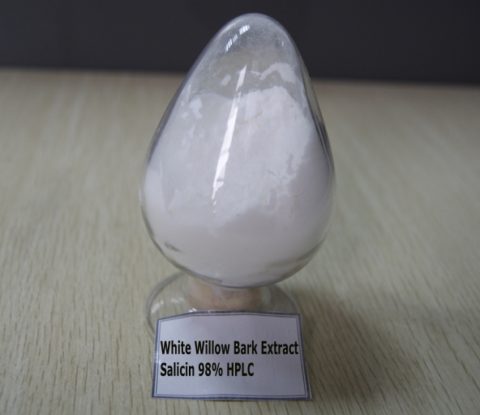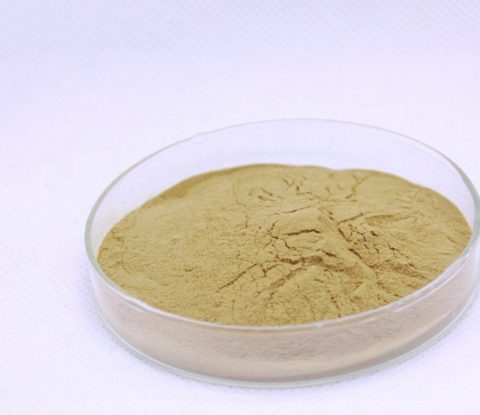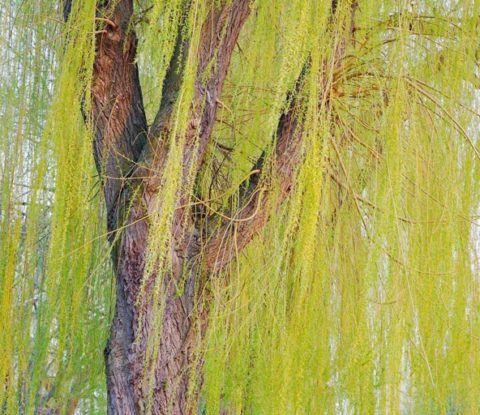
White Willow Bark Extract
【Botanical Source】: Salix alba L., Salix purpurea L., Salix fragilis L., and several other species. Family: Salicaceae (willow family)
【Common Names】: Willow , weidenrinde , white willow ( S. alba ), purple osier willow/basket willow ( S. purpurea ), crack willow ( S. fragilis )
【Specification】: Salicin 15%, 25%, 50%, 98%
【Testing method】: HPLC
【CAS No.】: 138-52-3 (Salicin)
【Main Function】: Ease aches and pains, Reduce fevers
【Synonyms】: Salicin (D-(−)-Salicin, salicoside, 2-(hydroxymethyl)phenyl-β-D-glucopyranoside)
【Chemical Name】:(2R,3S,4S,5R,6S)-2-(hydroxymethyl)-6-[2-(hydroxymethyl) phenoxy]oxane-3,4,5-triol
【Molecular Formula】: C13H18O7
【Mol. Wt.】:286.281
Brief Introduction
Salix alba(White Willow) is a species of willow native to Europe and western and central Asia. The name derives from the white tone to the undersides of the leaves. It is a medium-sized to large deciduous tree growing up to 10–30 m tall, with a trunk up to 1 m diameter and an irregular, often leaning crown. The bark is grey-brown, deeply fissured in older trees. The shoots in the typical species are grey-brown to green-brown. The leaves are paler than most other willows, due to a covering of very fine silky white hairs, particularly on the underside; they are 5–10 cm long and 0.5–1.5 cm wide. The flowers are produced in catkins in early spring, and pollinated by insects. It is dioecious, with male and female catkins on separate trees; the male catkins are 4–5 cm long, the female catkins 3–4 cm long at pollination, lengthening as the fruit matures. When mature in mid summer, the female catkins comprise numerous small (4 mm) capsules each containing numerous minute seeds embedded in white down which aids wind dispersal.
Hippocrates wrote in the 5th century BC about a bitter powder extracted from willow bark that could ease aches and pains and reduce fevers. This remedy is also mentioned in texts from ancient Egypt, Sumer, and Assyria. The Reverend Edmund Stone, a vicar from Chipping Norton in Oxfordshire, England, noted in 1763 that willow bark was effective in reducing a fever.
The active extract of the bark, called salicin, after the Latin name Salix, was isolated to its crystalline form in 1828 by Henri Leroux, a French pharmacist, and Raffaele Piria, an Italian chemist, who then succeeded in separating out the acid in its pure state. Salicylic acid, like aspirin, is a chemical derivative of salicin. Salicin is an alcoholic β-glucoside. Salicin is an anti-inflammatory agent that is produced from willow bark. It is also found in castoreum, which was used as an analgesic, anti-inflammatory, and antipyretic. The activity of castoreum has been credited to the accumulation of salicin from willow trees in the beaver’s diet, which is transformed to salicylic acid and has an action very similar to aspirin. Salicin is closely related in chemical make-up to aspirin. When consumed, the acetalic etherbridge is broken down. The two parts of the molecule, glucose and salicylic alcohol, then are metabolized separately. By oxidizing the alcohol function the aromatic part finally is metabolized to salicylic acid. Salicin elicits bitterness like quinine, when consumed. Alkaline cleavage of the glucoside populin produces benzoate and salicin.
Mild side effects are standard, with rare occurrences of nausea, vomiting, rash, dizziness and breathing problems. Overdose from high quantities of salicin can be toxic, damaging kidneys, stomach causing ulcers, diarrhea, bleeding or digestive discomfort. Some people may be allergic, or sensitive to salicylates, similar to reactions to aspirin. Others that are advised against taking salicin are those with asthma, diabetes, gout, gastritis, hemophilia, stomach ulcers, children under 16, pregnant and breastfeeding women.
Pharmacological Benefits
The ester glycosides salicortin, tremulacin, and fragilin can be considered to be prodrugs of salicylic acid, which deliver this compound into the systemic circulation without irritating the GI tract. Salicylic acid inhibits cyclooxygenase enzymes, which are involved in prostaglandin synthesis. The anti-inflammatory efficacy of tremulacin, a derivative of salicin, has been studied.
Anticancer activity
Willow bark and leaf extracts have documented anticancer activity. Mechanism of action may be associated with tumor inhibition leading to apoptosis, DNA damage, an affect on cell membranes, and/or denaturation of proteins.
In vitro data
The leaves of S. safsaf inhibited growth of acute myeloid leukemia cells. Another report found that willow extract killed 75% to 80% of abnormal cells harvested from 7 patients with acute lymphoblastic leukemia and 13 patients with acute myeloid leukemia. Willow bark extract inhibited tumor cell growth and induced apoptosis in human colon and lung cancer cell lines. The inhibitory effects were dose dependent.
Anti-inflammatory and antioxidant activity
Animal data
An animal model in rats was used to demonstrate that a standardized willow bark extract, on a milligram per kilogram basis, was as effective as acetylsalicylic acid (ASA) in reducing various inflammatory mediators.
In vitro data
The phenolic compounds are responsible for the antioxidant and free radical scavenging properties of the plant species.
Arthritis
Clinical data
Eighty-two patients with chronic arthritic pain were randomly assigned to receive a willow bark preparation or placebo for 2 months. Mild efficacy for improvement in pain symptoms with few adverse reactions was reported. Analysis of blood samples from a small study of 3 patients receiving a single dose of willow bark extract equivalent to salicin 240 mg found only moderate inhibition of cyclooxygenase.
Two 6-week, randomized, double-blind, clinical trials examined the efficacy of willow bark in treating 127 outpatients with hip or knee osteoarthritis and 26 outpatients with active rheumatoid arthritis. Patients with osteoarthritis received either salicin 240 mg/day, diclofenac 100 mg/day, or placebo. Patients with rheumatoid arthritis received salicin 240 mg/day or placebo. No efficacy was demonstrated in either disease state with willow bark.
Lower back pain
Clinical data
A 4-week, double-blind, clinical trial tested 2 oral doses of willow bark extract containing salicin 120 mg or 240 mg against placebo in 191 patients. Primary outcome measure was the number of patients requiring relief medication (tramadol) 5 out of 7 days during the final week of the study. Pain index measures showed reduction in relief medication with both doses of salicin. Patients receiving the 240 mg dose had more improvement in pain index measures. Moderate efficacy was demonstrated with both doses of salicin for short-term treatment of acute episodes of chronic nonspecific lower back pain. 43 Postmarketing surveillance of a proprietary willow bark extract product reported no serious adverse reactions.
Another 4-week, randomized, controlled study tested oral willow bark extract (salicin) 240 mg against rofecoxib 12.5 mg/day in 183 patients. Rofecoxib is no longer available, however both the salicin and rofecoxib group improved by 44% on pain index measures. There was no difference in efficacy between the 2 treatment groups.
Platelet aggregation
A 4-week trial involving 51 patients treated with Salicis cortex extract salicin 240 mg/day found that the plant had little effect on platelet aggregation when compared with a daily cardioprotective dose of acetylsalicylate 100 mg. The total serum salicylate concentration of salicin was bioequivalent to acetylsalicylate 50 mg.
Dosage
The typical dose is 300-900mg per day (usually in 2-3 doses throughout the day).






